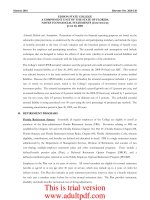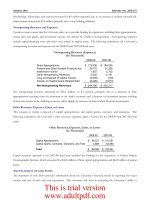REPORT NO. 2010-138 MARCH 2010 EDISON STATE COLLEGE _part3 docx
Bạn đang xem bản rút gọn của tài liệu. Xem và tải ngay bản đầy đủ của tài liệu tại đây (145.25 KB, 9 trang )
MARCH 2010 REPORT NO. 2010-138
15
College Component
Unit
REVENUES
Operating Revenues:
Student Tuition and Fees, Net of Scholarship
Allowances of $8,294,242 19,615,390$ $
Federal Grants and Contracts 1,158,502
Nongovernmental Grants and Contracts 1,899,210 5,397,390
Auxiliary Enterprises 1,283,597
Other Operating Revenues 927,672 1,596,798
Total Operating Revenues
24,884,371 6,994,188
EXPENSES
Operating Expenses:
Personnel Services 37,049,689
Scholarships and Waivers 8,194,940 3,202,669
Utilities and Communications 2,186,766
Contractual Services 6,214,054 2,062,808
Other Services and Expenses 3,850,028 682,945
Materials and Supplies 4,445,580
Depreciation 3,719,284
Total Operating Expenses
65,660,341 5,948,422
Operating Income (Loss)
(40,775,970) 1,045,766
NONOPERATING REVENUES (EXPENSES)
State Appropriations 24,129,603
Gifts and Grants 12,948,386
Investment Income 402,615 1,415,074
Other Nonoperating Revenues 2,552,970
Other Nonoperating Expenses (94,746) (12,047,526)
Net Nonoperating Revenues (Expenses)
39,938,828 (10,632,452)
Loss Before Other Revenues,
Expenses, Gains, or Losses
(837,142) (9,586,686)
Capital Appropriations 23,218,456
Capital Grants, Contracts, Gifts, and Fees 2,048,497 515,640
Increase to Permanent Endowments 199,781
Total Other Revenues
25,266,953 715,421
Increase (Decrease) in Net Assets
24,429,811 (8,871,265)
Net Assets, Beginning of Year 113,622,894 44,670,220
Net Assets, End of Year
138,052,705$ 35,798,955$
The accompanying notes to financial statements are an integral part of this statement.
EDISON STATE COLLEGE
A COMPONENT UNIT OF THE STATE OF FLORID
A
STATEMENT OF REVENUES, EXPENSES, AND CHANGES IN NET ASSETS
For the Fiscal Year Ended June 30, 2009
This is trial version
www.adultpdf.com
MARCH 2010 REPORT NO. 2010-138
16
College
CASH FLOWS FROM OPERATING ACTIVITIES
Tuition and Fees, Net 19,322,849$
Grants and Contracts 2,193,761
Payments to Suppliers (12,848,134)
Payments for Utilities and Communications (2,186,766)
Payments to Employees (28,830,218)
Payments for Employee Benefits (7,839,341)
Payments for Scholarships (8,194,940)
Net Loans Issued to Students (1,180,060)
Collection of Loans to Students 1,067,234
Auxiliary Enterprises 939,097
Other Receipts 660,282
Net Cash Used by Operating Activities
(36,896,236)
CASH FLOWS FROM NONCAPITAL FINANCING ACTIVITIES
State Appropriations 24,405,072
Gifts and Grants 15,229,546
Net Cash Provided by Noncapital Financing Activities
39,634,618
CASH FLOWS FROM CAPITAL AND RELATED FINANCING ACTIVITIES
Capital Appropriations 15,378,420
Capital Grants and Gifts 1,233,074
Proceeds from Sale of Capital Assets 610
Purchases of Capital Assets (12,265,263)
Principal Paid on Capital Debt and Leases (140,000)
Interest Paid on Capital Debt and Leases (94,746)
Net Cash Provided by Capital and Related Financing Activities
4,112,095
CASH FLOWS FROM INVESTING ACTIVITIES
Investment Income 402,613
Purchase of Investments (9,981,350)
Net Cash Used by Investing Activities
(9,578,737)
Net Decrease in Cash and Cash Equivalents
(2,728,260)
Cash and Cash Equivalents, Beginning of Year 20,987,845
Cash and Cash Equivale nts, End of Yea r
18,259,585$
EDISON STATE COLLEGE
A COMPONENT UNIT OF THE STATE OF FLORIDA
STATEMENT OF CASH FLOWS
For the Fiscal Year Ended June 30, 2009
This is trial version
www.adultpdf.com
MARCH 2010 REPORT NO. 2010-138
17
College
RECONCILIATION OF OPERATING LOSS
TO NET CASH USED BY OPERATING ACTIVITIES
Operating Loss (40,775,970)$
Adjustments to Reconcile Operating Loss
to Net Cash Used by Operating Activities:
Depreciation Expense 3,719,284
Changes in Assets and Liabilities:
Receivables, Net (1,580,155)
Prepaid Expenses (25,889)
Accounts Payable 1,432,074
Salaries and Payroll Taxes Payable 46,446
Deferred Revenue 2,781
Deposits Held for Others 2,343
Loans to Students and Employees (50,833)
Compensated Absences Payable 347,470
Special Termination Benefit Payable (36,570)
Postemployment Healthcare Benefits Payable 22,783
NET CASH USED BY OPERATING ACTIVITIES
(36,896,236)$
EDISON STATE COLLEGE
A COMPONENT UNIT OF THE STATE OF FLORIDA
STATEMENT OF CASH FLOWS (Continued)
For the Fiscal Year Ended June 30, 2009
The accompanying notes to financial statements are an integral part of this statement.
This is trial version
www.adultpdf.com
MARCH 2010 REPORT NO. 2010-138
EDISON STATE COLLEGE
A COMPONENT UNIT OF THE STATE OF FLORIDA
NOTES TO FINANCIAL STATEMENTS
J
UNE 30, 2009
18
1. SUMMARY OF SIGNIFICANT ACCOUNTING POLICIES
Reporting Entity
. The governing body of Edison State College
1
, a component unit of the State of Florida,
is the District Board of Trustees. The Board constitutes a corporation and is composed of nine members
appointed by the Governor and confirmed by the Senate. The District Board of Trustees is under the
general direction and control of the Florida Department of Education, Division of Florida Colleges, and is
governed by law and State Board of Education rules. However, the District Board of Trustees is directly
responsible for the day-to-day operations and control of the College within the framework of applicable
State laws and State Board of Education rules. Geographic boundaries of the District correspond with those
of Charlotte, Collier, Glades, Hendry, and Lee Counties.
Criteria for defining the reporting entity are identified and described in the Governmental Accounting
Standards Board’s Codification of Governmental Accounting and Financial Reporting Standards, Sections 2100 and
2600. These criteria were used to evaluate potential component units for which the District Board of
Trustees is financially accountable and other organizations for which the nature and significance of their
relationship with the District Board of Trustees are such that exclusion would cause the College’s financial
statements to be misleading or incomplete. Based upon the application of these criteria, the College is a
component unit of the State of Florida, and its financial balances and activity are reported in the State’s
Comprehensive Annual Financial Report by discrete presentation.
Blended Component Unit
. Based on the application of the criteria for determining component units, the
Edison State College Financing Corporation (Financing Corporation) is included within the College’s
reporting entity as a blended component unit. The Financing Corporation is a not-for-profit Florida
corporation under the provisions of Chapter 617, Florida Statutes, and is also a direct-support organization,
as defined in Section 1004.70, Florida Statutes. The Financing Corporation is managed independently,
outside the College’s budgeting process, and its powers generally are vested in a governing board pursuant to
various State Statutes. The Financing Corporation was established to finance and/or operate parking,
student housing, and other capital projects for the exclusive benefit of the College and its students. Due to
the substantial economic relationship between the Financing Corporation and the College, the financial
activities of the Financing Corporation are included in the College’s financial statement.
1
The College’s Board of Trustees approved the name change from Edison College to Edison State College on August 18, 2008,
pursuant to Section 1001.60(2)(b), Florida Statutes.
This is trial version
www.adultpdf.com
MARCH 2010 REPORT NO. 2010-138
EDISON STATE COLLEGE
A COMPONENT UNIT OF THE STATE OF FLORIDA
NOTES TO FINANCIAL STATEMENTS (C
ONTINUED)
J
UNE 30, 2009
19
The Financing Corporation is audited by other auditors, pursuant to Section 1004.70(6), Florida Statutes.
The Financing Corporation’s audited financial statements are available to the public at the College.
Discretely Presented Component Unit
. Based on the application of the criteria for determining
component units, the Edison State College Foundation, Inc. (Foundation), is included within the College’s
reporting entity as a discretely presented component unit.
The Foundation is audited by other auditors pursuant to Section 1004.70(6), Florida Statutes. The
Foundation’s audited financial statements are available to the public at the College. The financial data
reported on the accompanying financial statements was derived from the Foundation’s audited financial
statements for the fiscal year ended March 31, 2009.
The Foundation is also a direct-support organization, as defined in Section 1004.70, Florida Statutes, and
although legally separate from the College, is financially accountable to the College. The Foundation is
managed independently, outside the College’s budgeting process, and its powers generally are vested in a
governing board pursuant to various State statutes. The Foundation receives, holds, invests, and administers
property and makes expenditures to or for the benefit of the College.
Basis of Presentation
. The College’s accounting policies conform with accounting principles generally
accepted in the United States of America applicable to public colleges and universities as prescribed by the
Governmental Accounting Standards Board (GASB). The National Association of College and University
Business Officers (NACUBO) also provides the College with recommendations prescribed in accordance
with generally accepted accounting principles promulgated by GASB and the Financial Accounting
Standards Board (FASB). GASB allows public colleges various reporting options. The College has elected
to report as an entity engaged in only business-type activities. This election requires the adoption of the
accrual basis of accounting and entitywide reporting including the following components:
¾ Management’s Discussion and Analysis
¾ Basic Financial Statements:
• Statement of Net Assets
• Statement of Revenues, Expenses, and Changes in Net Assets
• Statement of Cash Flows
• Notes to Financial Statements
Basis of Accounting
. Basis of accounting refers to when revenues, expenses, and related assets and
liabilities are recognized in the accounts and reported in the financial statements. Specifically, it relates to the
This is trial version
www.adultpdf.com
MARCH 2010 REPORT NO. 2010-138
EDISON STATE COLLEGE
A COMPONENT UNIT OF THE STATE OF FLORIDA
NOTES TO FINANCIAL STATEMENTS (C
ONTINUED)
J
UNE 30, 2009
20
timing of the measurements made, regardless of the measurement focus applied. The College’s financial
statements are presented using the economic resources measurement focus and the accrual basis of
accounting. Revenues, expenses, gains, losses, assets, and liabilities resulting from exchange and
exchange-like transactions are recognized when the exchange takes place. Revenues, expenses, gains, losses,
assets, and liabilities resulting from nonexchange activities are generally recognized when all applicable
eligibility requirements, including time requirements, are met.
The College’s component units use the economic resources measurement focus and accrual basis of
accounting whereby revenues are recognized when earned and expenses are recognized when incurred, and
follows GASB standards of accounting and financial reporting.
The College follows FASB statements and interpretations issued after November 30, 1989, unless those
pronouncements conflict with GASB pronouncements.
Interdepartmental sales between auxiliary service departments and other institutional departments have been
accounted for as reductions of expenses and not revenues of those departments.
The College’s principal operating activity is instruction. Operating revenues and expenses generally include
all fiscal transactions directly related to instruction as well as administration, academic support, student
services, physical plant operations, and depreciation of capital assets. Nonoperating revenues include State
appropriations, Federal and State student financial aid, investment income (net of unrealized gains or losses
on investments), and revenues for capital construction projects. Interest on capital asset-related debt is
considered a nonoperating expense.
The statement of net assets is presented in a classified format to distinguish between current and noncurrent
assets and liabilities. When both restricted and unrestricted resources are available to fund certain programs,
it is the College’s policy to first apply the restricted resources to such programs followed by the use of the
unrestricted resources.
The statement of revenues, expenses, and changes in net assets is presented by major sources and is reported
net of tuition scholarship allowances. Tuition scholarship allowances are the differences between the stated
charge for goods and services provided by the College and the amount that is actually paid by the student or
the third party making payment on behalf of the student. The College applied “The Alternate Method” as
prescribed in NACUBO Advisory Report 2000-05 to determine the reported net tuition scholarship
allowances. Under this method, the College computes these amounts by allocating the cash payments to
This is trial version
www.adultpdf.com
MARCH 2010 REPORT NO. 2010-138
EDISON STATE COLLEGE
A COMPONENT UNIT OF THE STATE OF FLORIDA
NOTES TO FINANCIAL STATEMENTS (C
ONTINUED)
J
UNE 30, 2009
21
students, excluding payments for services, on a ratio of total aid to the aid not considered to be third-party
aid.
The statement of cash flows is presented using the direct method in compliance with GASB Statement
No. 9, Reporting Cash Flows of Proprietary and Nonexpendable Trust Funds and Governmental Entities
That Use Proprietary Fund Accounting.
Cash and Cash Equivalents
. The amount reported as cash and cash equivalents consists of cash on hand,
cash in demand accounts, cash invested in money market mutual funds, and cash placed with the State
Treasury Special Purpose Investment Account (SPIA) and State Board of Administration Local Government
Surplus Funds Trust Fund Investment Pool (LGIP). For the purpose of reporting cash flows, the College
considers all highly liquid investments with original maturities of three months or less to be cash equivalents.
Under this definition, the College considers amounts invested in the SPIA and LGIP to be cash equivalents.
College cash deposits are held in banks qualified as public depositories under Florida law. All such deposits
are insured by Federal depository insurance, up to specified limits, or collateralized with securities held in
Florida’s multiple financial institution collateral pool required by Chapter 280, Florida Statutes. Cash and
cash equivalents that are externally restricted to make debt service payments, maintain sinking or reserve
funds, or to purchase or construct capital or other restricted assets are classified as restricted.
At June 30, 2009, the College reported as cash equivalents at fair value $38,377 of moneys held in the State
Treasury SPIA investment pool representing ownership of a share of the pool, not the underlying securities.
The SPIA carried a credit rating of A+f by Standard & Poor’s and had an effective duration of 1.84 years at
June 30, 2009. The College relies on policies developed by the State Treasury for managing interest rate risk
or credit risk for this investment pool. Disclosures for the State Treasury investment pool are included in
the notes to financial statements of the State’s Comprehensive Annual Financial Report.
At June 30, 2009, the College reported as cash equivalents at fair value $9,577 of moneys held in the LGIP
administered by the State Board of Administration (SBA) pursuant to Section 218.405, Florida Statutes. The
College’s investments in the LGIP, which the SBA indicates is a Securities and Exchange Commission Rule
2a7-like external investment pool, as of June 30, 2009, are similar to money market funds in which shares are
owned in the fund rather than the underlying investments. The LGIP carried a credit rating of AAAm by
Standard & Poor’s and had a weighted-average days to maturity (WAM) of 46 days as of June 30, 2009. A
portfolio’s WAM reflects the average maturity in days based on final maturity or reset date, in the case of
floating-rate instruments. WAM measures the sensitivity of the LGIP to interest rate changes. The
investments in the LGIP are reported at fair value, which is amortized cost.
This is trial version
www.adultpdf.com
MARCH 2010 REPORT NO. 2010-138
EDISON STATE COLLEGE
A COMPONENT UNIT OF THE STATE OF FLORIDA
NOTES TO FINANCIAL STATEMENTS (C
ONTINUED)
J
UNE 30, 2009
22
Capital Assets
. College capital assets consist of land; art collections; construction in progress; buildings;
other structures and improvements; and furniture, machinery, and equipment. These assets are capitalized
and recorded at cost at the date of acquisition or at estimated fair value at the date received in the case of
gifts and purchases of State surplus property. Additions, improvements, and other outlays that significantly
extend the useful life of an asset are capitalized. Other costs incurred for repairs and maintenance are
expensed as incurred. The College has a capitalization threshold of $5,000 for tangible personal property
and $25,000 for buildings and other structures and improvements. Depreciation is computed on the
straight-line basis over the following estimated useful lives:
¾ Buildings – 40 years
¾ Other Structures and Improvements – 10 years
¾ Furniture, Machinery, and Equipment:
• Computer Equipment – 3 years
• Vehicles, Office Machines, Educational Equipment – 5 years
• Furniture – 7 years
Noncurrent Liabilities
. Noncurrent liabilities include principal amounts of bonds payable,
postemployment healthcare benefits payable, special termination benefits payables, and compensated
absences payable that are not scheduled to be paid within the next fiscal year.
2. INVESTMENTS
The College’s Board of Trustees has adopted a written investment policy providing that surplus funds of the
College shall be invested in those institutions and instruments permitted under the provisions of Florida
Statutes. Section 218.415(16), Florida Statutes, authorizes the College to invest in the Local Government
Surplus Funds Trust Fund investment pool administered by the State Board of Administration;
interest-bearing time deposits and savings accounts in qualified public depositories, as defined by
Section 280.02, Florida Statutes; direct obligations of the United States Treasury; obligations of Federal
agencies and instrumentalities; securities of, or interests in, certain open-end or closed-end management type
investment companies; Securities and Exchange Commission registered money market funds with the
highest credit quality rating from a nationally recognized rating agency; and other investments approved by
the College’s Board of Trustees as authorized by law. State Board of Education Rule 6A-14.0765(3), Florida
Administrative Code, provides that College loan, endowment, annuity, and life income funds may also be
invested pursuant to Section 215.47, Florida Statutes. Investments authorized by Section 215.47, Florida
Statutes, include bonds, notes, commercial paper, and various other types of investments. Investments set
This is trial version
www.adultpdf.com
MARCH 2010 REPORT NO. 2010-138
EDISON STATE COLLEGE
A COMPONENT UNIT OF THE STATE OF FLORIDA
NOTES TO FINANCIAL STATEMENTS (C
ONTINUED)
J
UNE 30, 2009
23
aside to make debt service payments, maintain sinking or reserve funds, or to purchase or construct capital
assets are classified as restricted.
The College’s investments at June 30, 2009, are reported at fair value, as follows:
Investment Type Amount
State Board of Administration Fund B
Surplus Funds Trust Fund 95,268$
Federal Agency Obligations 10,232,116
Mutual Funds 511,559
Total College Investments
10,838,943$
State Board of Administration Fund B Surplus Funds Trust Fund
On December 4, 2007, the State Board of Administration (SBA) restructured the Local Government Surplus
Funds Trust Fund (LGIP) to also establish the Fund B Surplus Funds Trust Fund (Fund B). Fund B, which
is administered by the SBA pursuant to Sections 218.405 and 218.417, Florida Statutes, is not subject to
participant withdrawal requests. Distributions from Fund B, as determined by the SBA, are effected by
transferring eligible cash or securities to the LGIP, consistent with the pro rata allocation of pool
shareholders of record at the creation date of Fund B. One hundred percent of such distributions from
Fund B are available as liquid balance within the LGIP.
At June 30, 2009, the College reported investments at fair value of $95,268 for amounts held in Fund B. The
College’s investments in Fund B are accounted for as a fluctuating net asset value pool, with a fair value
factor of 0.5137 at June 30, 2009. The weighted-average life (WAL) of Fund B at June 30, 2009, was
6.87 years. A portfolio’s WAL is the dollar-weighted average length of time until securities held reach
maturity and is based on legal final maturity dates for Fund B as of June 30, 2009. WAL measures the
sensitivity of Fund B to interest rate changes. The College’s investment in Fund B is unrated.
Other Investments
The College’s investments at June 30, 2009, included $10,232,116 of Federal agency obligations reported at
fair value. The College’s investments at June 30, 2009, also included $511,559 that consisted of mutual funds
reported at fair value that are held as part of its endowments.
The following risks apply to these investments:
Interest Rate Risk: Interest rate risk is the risk that changes in interest rates will adversely affect the fair value
of an investment. The College’s investment policy limits interest rate risk by attempting to match investment
maturities with known cash needs and anticipated cash flow requirements. Investments of nonoperating
This is trial version
www.adultpdf.com









